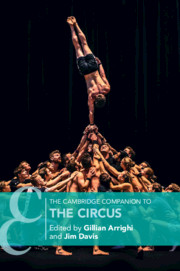Book contents
- The Cambridge Companion to the Circus
- Cambridge Companions to Theatre and Performance
- The Cambridge Companion to the Circus
- Copyright page
- Contents
- Figures
- Contributors
- Acknowledgements
- Timeline
- Introduction
- Part I Transnational Geographies of the Modern Circus
- Chapter 1 The Origins and Growth of the Modern Circus
- Chapter 2 Reconstruction, Railroads, and Race
- Chapter 3 Circus, Colonialism, and Empire
- Chapter 4 The Criollo Circus (Circus Theatre) in Argentina
- Chapter 5 The Past and Present of Czech Circus
- Chapter 6 Catching On
- Part II Circus Acts and Aesthetics
- Part III Circus
- Part IV Circus Studies Scholarship
- Bibliography
- Index
- References
Chapter 4 - The Criollo Circus (Circus Theatre) in Argentina
The Emergence of a Unique Circus Form in Connection with the Consolidation of the Argentine Nation State
from Part I - Transnational Geographies of the Modern Circus
Published online by Cambridge University Press: 22 June 2021
- The Cambridge Companion to the Circus
- Cambridge Companions to Theatre and Performance
- The Cambridge Companion to the Circus
- Copyright page
- Contents
- Figures
- Contributors
- Acknowledgements
- Timeline
- Introduction
- Part I Transnational Geographies of the Modern Circus
- Chapter 1 The Origins and Growth of the Modern Circus
- Chapter 2 Reconstruction, Railroads, and Race
- Chapter 3 Circus, Colonialism, and Empire
- Chapter 4 The Criollo Circus (Circus Theatre) in Argentina
- Chapter 5 The Past and Present of Czech Circus
- Chapter 6 Catching On
- Part II Circus Acts and Aesthetics
- Part III Circus
- Part IV Circus Studies Scholarship
- Bibliography
- Index
- References
Summary
A unique circus form known as Criollo Circus (or Circus Theatre) became established in Argentina in the late nineteenth century, characterised by a performance that was divided into two parts. The first part comprised of exhibitions of various traditional circus techniques, while the second part presented a theatrical piece based on the criollista gaucho genre, a theatre genre derived from the literary movement that extolled the figure of the Argentine gaucho as an emblem of nationality. This fusion of physically based circus arts with a vernacular style of theatrical representation founded on text, melodrama, and social criticism not only produced an innovative mode of performance unique to Argentina, it also provoked changes in the evaluation of these popular performance forms. Between 1880 and 1910 the status of both the circus and the criollista-gaucho genre shifted from ‘minor arts’ to validation as the origins of the authentic Argentinian national theatre. This chapter discusses the emergence and legitimisation of the Criollo Circus, examines its stylistic and thematic characteristics, and evaluates the imprint it has left on the subsequent national circus and theatre forms. It also analyses the construction of hierarchies based on the valuation of spoken drama and high art over popular bodily based performances.
Keywords
- Type
- Chapter
- Information
- The Cambridge Companion to the Circus , pp. 63 - 77Publisher: Cambridge University PressPrint publication year: 2021



